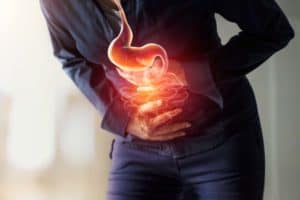What is gout?
- Gout is a disorder of purine metabolism and the most common inflammatory monoarthritis in men and in older women caused by the deposition of uric acid crystals called monosodium urate monohydrate crystals in and around synovial joints and characterized by sudden severe inflammation of joints, often at the base of the big toe.
- Gout has become progressively more common over recent years due to the increased prevalence of obesity and metabolic syndrome.
Epidemiology
- Incidence: Approximately 1–2% of the population.
- Sex: Males are more affected than females and the ratio is 5:1.
- Age: age of onset is particularly 40-60 years. The risk of developing gout increases with age with a peak age of 75 and after menopause in women.
Pathophysiology
- Gout occurs due to the accumulation of needle-shaped monosodium urate monohydrate crystals in the joint.
- High blood uric acid level is the cause for crystal formation.
- About one-third of the body’s uric acid pool is derived from dietary sources and two-thirds from endogenous purine metabolism.
- Uric acid dissolves in the blood and is eliminated by the kidneys through urine. But sometimes uric acid builds up in excess. When too much uric acid is produced in our body or kidneys are unable to excrete enough uric acid, it causes the formation and deposition of positively birefringent needle-like urate crystals in the joint or surrounding tissue.
Risk factors of gout
- Positive Family history of gout
- Hyperuricemia is a strong risk factor for the development of gout which is defined as a serum uric acid level more than 2 standard deviations above the mean for the population. Hyperuricemia can be due to uric acid overproduction or under-excretion.
- Metabolic conditions
- Untreated high blood pressure
- Hyperlipidemia
- Diabetes mellitus
- Obesity
- Drugs:
- Thiazide and loop diuretics
- Low-dose aspirin
- Ciclosporin
- Pyrazinamide
- Diet
- Seafood
- Red meat
- Alcohol consumption, especially of beer
- Beverages sweetened with fructose
- Game
- Offal
- Renal failure
- Lead toxicity
- Lactic acidosis
- Starvation/dehydration
- Chemotherapy and radiotherapy during cancer treatment
- Myeloproliferative and lymphoproliferative disease
- Psoriasis
- Inherited disorders:
- Lesch–Nyhan syndrome (a deficiency of the enzyme hypoxanthine-guanine phosphoribosyltransferase)
- Glycogen storage disease
Clinical features
- Intense severe pain most commonly affecting the base of the big toe in over 50% of cases although it can affect any synovial joint.
- Rapid onset of pain becomes very severe within a few hours. The pain can even wake a patient up from deep sleep at night.
- Joint swelling
- Redness
- The raised temperature around the joint
- Limited range of motion in affected joint
- Fever and malaise
- Self-limiting over 5–14 days, with complete resolution.
- The overlying skin may disquamate.
Stages of classical gout
- Asymptomatic hyperuricemia
- Only biochemical abnormality
- There is some excess uric acid but most of the patients do not develop any symptoms.
- Acute intermittent gout
- Intermittent acute attacks
- It is otherwise known as gouty arthritis
- Intercritical gout
- Long symptom-free intervals between the attacks of gout
- Chronic tophaceous gout
Differential diagnosis
- Pseudogout
- Septic arthritis
- Psoriatic arthritis
- Rheumatoid arthritis
- Infective cellulitis
- Reactive arthritis
- Osteoarthritis
- Bursitis
- Tenosynovitis
Investigations
Joint fluid aspirate test with topical local anesthesia
- The fluid may appear turbid in acute inflammation due to elevated neutrophils or white in case of chronic gout.
- The diagnosis of gout can be confirmed by the identification of urate crystals in the aspirate from a joint, bursa, or tophus
Blood tests
- Complete blood count with CRP (elevated ESR and CRP and with a neutrophilia)
- Serum uric acid
- Serum creatinine
- Blood glucose
Lipid profile
X-rays of affected limbs: Well-demarcated erosions may be seen in patients with chronic or tophaceous gout. Tophi may also be visible on X-rays as soft tissue swellings.
Ultrasound of affected joints: Urate crystals can be detected.
Dual-energy CT scan: It is more sensitive than an ultrasonogram. It can detect urate crystals even in a non-inflamed joint. This test is not widely available and expensive due to which it is not routinely used in clinical practice.
Management of gout
Aim of management-
- Patient education
- Terminating acute attack
- Control pain and inflammation
- Preventing further attacks by prophylaxis to lower serum uric acid level
- Preventing complications
Patient education
Educate the patients about
- Weight loss
- Limit high purine diets
- Smoking and alcohol cessation
- Daily exercise
- Plenty of fluids intake
- Several antihypertensive drugs, including thiazides, β-blockers, and ACE inhibitors, increase uric acid levels and thus should be replaced if possible with losartan which has a uricosuric effect.
Terminating acute attack
Drugs:
Oral colchicine (0.5 mg twice or 3 times daily):
- It is the first treatment of choice in acute gout.
- Side effects occur if taken in larger doses such as nausea, vomiting, and diarrhea.
Oral NSAIDs
- Eg. Ibuprofen, naproxen sodium, indomethacin, celecoxib
- Side effects include stomach ulcers, pain, and bleeding.
Corticosteroids
- Oral prednisolone (15–20 mg daily) or intramuscular/intra-articular methylprednisolone (80–120 mg daily) for 2–3 days
- They are highly effective and are a good choice in elderly patients where there is an increased risk of toxicity with colchicine and NSAID.
Allopurinol should not be given in an acute attack of gout but can be continued if the patient is already taking it as prophylaxis.
Conservative measures:
- Local ice packs
- Rest and elevate the affected limb
- Keep bedclothes away from the affected joint at night
Surgery:
- Joint aspiration under local anesthesia can give pain relief, particularly if a large joint is affected, and may be combined with an intra-articular glucocorticoid injection.
Prophylaxis to prevent further gout attacks
Aim of prophylaxis:
- The aim is to prevent the gout attack before occurring. Measures should be talked to keep the uric acid level below 6 mg/dL. Because above this level, the uric acid shows a tendency to crystalize.
Indication:
- Recurrent gouty arthritis
- Evidence of bone or joint damage
- Tophi
- Chronic kidney disease
- Uric acid kidney stones
Drugs:
- Urate-lowering therapy: inhibit the uric acid synthesis
- Allopurinol (xanthine oxidase inhibitor) is the first drug of choice
- Febuxostat
- Uricosuric drugs: Probenecid, sulfinpyrazone and benzbromarone
- Biological agent: Pegloticase
Complications
- Chronic Gout: Repeated gout attack, may cause deposition of urate crystals under the skin of joints and soft tissues to form irregular firm nodules called tophi. Tophi have a whitish color differentiating them from rheumatoid nodules. Trophi can occasionally become perforated and infectious. This may progress to severe deformity and functional impairment.
- Kidney stone: Chronic hyperuricemia may cause the deposition of urate crystals in the urinary tract, causing kidney stones.
- Urate nephropathy: It can cause renal impairment due to the development of interstitial nephritis as a result of urate deposition in the kidney. This is particularly common in patients with chronic tophaceous gout who are on diuretic therapy.
Read this article to learn the difference between gout and rheumatoid arthritis: https://creakyjoints.org/symptoms/gout-vs-rheumatoid-arthritis/
Please write in the comment section what did you think about our ‘what is gout’ article.
Go back to our blog to read more articles.



